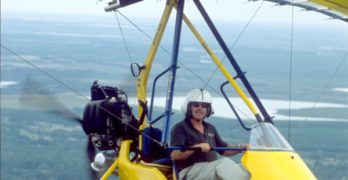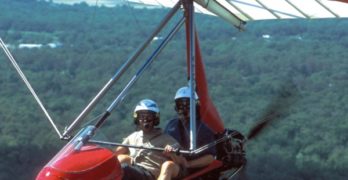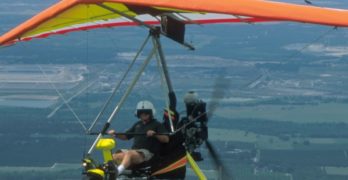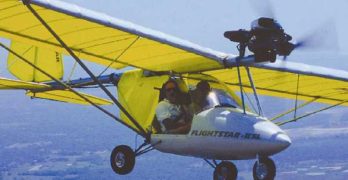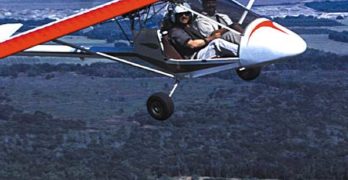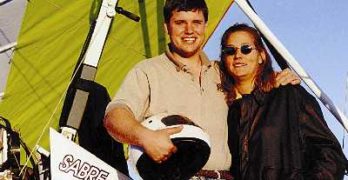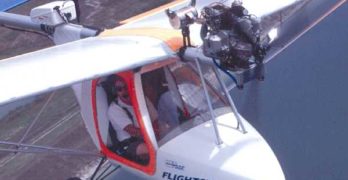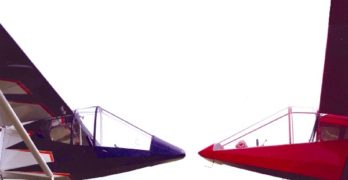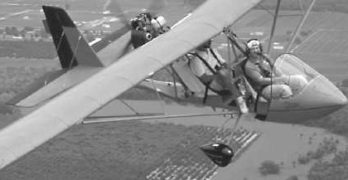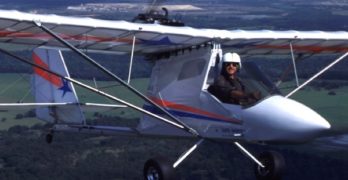French manufacturer Aquilair wants you to get in the “swing” of triking with their 2-seat trike, the Swing. The trike’s sporty name identifies what the French company calls their “chariot” (chassis or carriage). The name may also derive from the company’s unique fold-down system.
Most trikes pivot at the base of the mast (the component connecting occupants and engine to wing) or at a mid-mast point about engine height. Aquilair pivots the mast under the front seat – or the only seat in the case of their single-place model, the Kid. Placing the pivot point this far forward allows the company to offer easier lifting of the wing into position without using weighty and costly gas struts. The result is a simpler, lighter package that accomplishes the goal of letting one person erect the trike from its transport state.
The feature is driven, I was told, by the 90-pound female owner of Aquilair.
Search Results for : Four stroke and ultralight
Not finding exactly what you expected? Try our advanced search option.
Select a manufacturer to go straight to all our content about that manufacturer.
Select an aircraft model to go straight to all our content about that model.
South Africa’s Aerotrike Goes First Class
First came the Aerotrike. Travelling all the way from South Africa where Rainbow Aircraft manufactures it, the Aerotrike looked to be – and is – a very sturdy trike that could stand the rigors of flight instruction. However, some thought it lacked the finesse of the finest European trikes.
Designed by Mike Blyth, the Aerotrike was built precisely for the purpose of flight training. For years, Blyth had used other brands of trikes in his flight school. However, he found they wore out prematurely. This is never a good thing to a school trying to fund itself by teaching many students.
The Aerotrike’s Scout and Safari models proved to be durable flying machines. Former American representative Rob Rollison fitted his Aerotrike with a reliable HKS 4-stroke engine and proceeded to fly a lengthy 2,000-mile journey around Mexico. Not everyone would tackle such a venture, but Rollison says the HKS and his sturdy Aerotrike gave him the confidence to simply fly and enjoy.
South African Star
Not long ago, Americans couldn’t buy products from South Africa because of that country’s apartheid policies. Our government employed economic sanctions that kept South African aviation developments off our radar. However, as their ultralight producers did business with Europe, the Southern Hemisphere country kept up with ultralight aviation despite the sanctions imposed by the United States.
One South African ultralight product is the Aquilla, a sturdy trike from Solo Wings in South Africa.
If the name Aquilla sounds vaguely familiar and a bit Italian to you, go to the head of the class. You’d be right on both counts. Aquila – spelled with one “l” – is a constellation in the Northern Hemisphere and the Milky Way. Exactly how a star in the northern skies inspired someone in South Africa I don’t know. Aquila is also a city of central Italy northeast of Rome.
Nonetheless, Solo Wings owner Aidan De Gersigny, who has been involved with hang gliding since the late 1970s, says Aquilla means “Eagle” in Latin, a name he used for a hang glider he sold 15 years ago.
Flightstar II SL
Since Tom Peghiny and partner Spark Lamontagne first lightened the Flightstar and named one model the II SL (for “Sport Light”), they haven’t been able to sit still and simply admire their work. From our first pilot’s report on the SL 3 years ago,1 the two have tweaked and adjusted the model to find even better qualities.
A new front and aft fairing are part of the package, and the latter you might notice rather quickly. Virtually all the rest of the improvements are subtle things. In fact, that word is a hallmark of Flightstar innovation.
No surprise then that the company should adopt “New and Improved” as its new advertising headline to assure you know about the changes.
Better and Better
I’ve followed the Flightstar from its first flight, when it wasn’t even the Flightstar. This design – which once crossed the Atlantic – is from the inventive mind of Swiss national Hans Gygax, and became the rather gaudy 440ST.
New Kolb Aircraft
Sometimes I’m amazed that we’ve now got ultralight pilots buying engines that cost more than $10,000. Twenty years ago, Eipper Formance (Quicksilver) sold complete ultralights that cost $3,499. Even in the ’90s, many complete ultralights – engine and all – cost less than the price of a Rotax 912 4-stroke engine on its own. One that meets that description is Kolb Aircraft’s Mark III with a 50-hp Rotax 503 dual carb 2-cycle engine.
Nonetheless, the 81-hp Rotax 912 has invaded the realm of what is loosely called “ultralight” flying. Of course, a Rotax 912-powered aircraft simply cannot be used on a single-place Part 103 ultralight. And any 2-place plane with a 912 is less likely to qualify as an ultralight trainer under the training exemption to FAR Part 103; the big engine may push the plane too fast and could make it heavier than 496 pounds (the ultralight trainer empty weight limit).
Aeros Venture from Sabre
Only a little more than 10 years ago, the wall fell in Berlin, Germany and Communism collapsed in the USSR. Before these momentous events, few Americans knew anything about the Ukraine (which was part of the USSR) and even those who did were largely unaware of its ability to produce aircraft.
Yet by the mid-1990s, some Americans became aware of a Ukrainian company named Aeros. One man became an importer of their hang glider line. G.W. Meadows and his Thermal Riding Vehicles business sold so many hang gliders from the former Soviet satellite that the American market leader, Wills Wing, had to drop prices to remain competitive with the lower cost hang gliders from eastern Europe.
In this article I’ll review the Venture, the newest Aeros model for the American ultralight market. But this new Aeros ultralight follows the Aeros Antares (once known as Graffiti), reviewed in the December 1997 issue of Ultralight Flying!
Flightstar II Sport Cabin
In August 1999,Ultralight Flying! reported on the Flightstar II SL. Thirteen months later, another report is needed as, once again, Tom Peghiny and Spark Lamontagne have upgraded their principal selling model.
Flightstar is the name of the plane and Flightstar Sportplanes is the name of the company, and “refinement” ought to be permanently attached. I’ve followed many ultralights over many years. Some have changed a lot, some have seen almost no change. The Flightstar has almost constantly evolved.
Why change this successful design? After all, it costs money to design, test and build new parts inventories. It takes time and more money to update assembly manuals. Why do all this if the ultralight is doing well? The reason is simple: to make a better product that more people will buy. At least the answer sounds simple; in fact, it may be surprisingly complicated to achieve.
Before we get into how the ultralight flies, let’s review what makes this Flightstar II SC (Sport Cabin) different from the Flightstar II SL (Sport Light).
New Kolbra ULT
For ultralight enthusiasts, the focus of this pilot report is on the Kolbra model that I flew in late summer 2000, fitted with the 66-hp Rotax 582. A King Kolbra version is also available, but because it is equipped with the 80-hp 4-stroke, 4-cylinder Jabiru engine, it cannot make FAR Part 103 trainer exemption weight limits.
The two new Kolbra offerings give The New Kolb Aircraft Company a better footing in the 2-seat market. Until now, of the five models New Kolb offered for sale, the Mark III was their only 2-seater. Another 2-seater, the low-wing Laser, never made it to market and the outlook appears uncertain for any introduction of that model.
The New Kolb Aircraft Company is clearly focused on 2-seaters. The company released a new version of their popular Mark III, named the Mark III Xtra, in the spring of 2000 and now the Kolbras. Their single-seaters – the FireFly, FireStar, FireStar II (with optional jump seat but no dual controls), and SlingShot – remain unchanged… and that’s a very good thing in my opinion.
Drifter SB
One-time Aussie distributor Chris Blackwell claimed sales in excess of 200 units – and this was the American-produced version from the Maxair company. It proved no impediment that Drifter kits had to be shipped halfway around the Earth to reach the land of kangaroos.
Sometime after this illustrious and energetic time, things went south for Maxair in more than just a financial way. Through a labyrinth of twists and turns, a Florida man named Don Jones ended up owning the one-time Pennsylvania company in a set of circumstances most charitably called “questionable.” At best, he kept the design alive. At worst, he sunk the design into near oblivion.
Fortunately, good things tend to stick around, regardless of how badly they’re treated. The Drifter is an example.
Perhaps because the Drifter made it to Australia in large numbers, the ’97 incarnation of the tandem aircraft now returns from the country on the bottom side of the globe.
Talon Super Magnum
Among the aircraft produced by Sport Flight Aviation are the tandem 2-seat Talon XP, the Talon Magnum single-seater, and our plane for this test, the single-seat Talon Super Magnum. The energized version comes from the substantial 80-hp twin-cylinder 4-stroke engine that pushes the single-seater aloft with an enthusiasm that is truly inspirational.
Published in Light Sport and Ultralight Flying
Seating
Single-seat
Empty weight
494 pounds
Gross weight
1,056 pounds
Wingspan
29 feet 6 inches
Wing area
156 square feet
Wing loading
6.8 pounds/sq ft
Length
21 feet 9 inches
Height
6 feet 4 inches
Fuel Capacity
10 gallons
Kit type
Assembly
Build time
130-150 hours
Standard engine
Verner SVS-1400 4-cycle
Power
80 hp at 5,000 rpm
Power loading
13.2 pounds/hp
Cruise speed
76 mph at 3,900 rpm
Never exceed speed
110 mph
Rate of climb at gross
1,000 fpm
Takeoff distance at gross
170-200 feet
Landing distance at gross
300 feet
Standard Features
3-position flaps, rudder trim, steerable tailwheel with takeoff/landing lockout, 4130 chromoly steel landing gear, streamlined struts, windscreen, nose fairing, instrument panel, 4-point shoulder harness pilot restraint, aluminum wheels, padded seat, cargo area.


